Introduction
PN junction is a significant building block and it is one among the indispensable structures offered by the semiconductor technology in electronics. Electronic components such as bipolar junction transistors, junction FETs and MOSFETs, or diodes such as light-emitting diodes (LEDs), and analog or digital integrated circuits (ICs) are all supported in semiconductor technology. The exciting property of semiconductor diode is facilitating the electrons to flow exclusively in one direction across it; as a result it acts as a rectifier of Alternating Current. The indispensable operation in semiconductor diode is the basis for understanding of all the semiconductor diodes.
The diode can be observed as a straightforward bipolar semiconductor device. The characteristics of diode look to be a graph of current that a diode produces when the voltage applied to it. A perfect diode can be absolutely distinguished by its current and voltage curve. It permits the current to flow solely in forward direction and effectively blocks the current in the reverse direction. It is vital to recognize that the semiconductor is entirely a single-crystal material, made from two separate blocks of semiconductor opposite kind. One block is doped with trivalent impurity atoms to create the P region that acts as acceptors with holes as majority charge carriers and the adjacent block is doped with pentavalent impurity atoms to create the N region that acts as donors with electrons as majority charge carriers. The boundary splitting the n and p region is referred to as the metaphysical junction. The concentration of doping is same all over in every block and there will be an abrupt modification in doping at the junction. When the two blocks are placed nearer to each other, the electrons and holes diffuse towards the region of lower concentration from the region of higher concentration. In the process of diffusion, electrons from N region diffuse towards the P region whereas holes from P region diffuse towards the N region. Once holes enter the N region, they will recombine with donor atoms. At the same time, donor atoms admit additional holes and become positively charged stationary donor atoms. The electrons spreading from N region to P region recombine with the acceptor atoms in P region. At the same time, acceptor atoms admit additional electrons and become negatively charged immobile acceptor atoms. As a result, a large number of positively charged ions are produced at the junction on the N side and a large number of negatively charged ions are produced at the junction on P side. The net positively and negatively charged ions within the N and P regions induce an electric field in the space near to the metaphysical junction. Merging these two regions wherever the electric field is small and wherever the free carrier density is equivalent to the net doping density can be named as the space charge region. It can also be referred as a quasi neutral region. Fundamentally, all electrons and holes are swept out of the free space charge region by the electric field. The tapered region in which depletion of free mobile charge carriers takes place is called as Depletion Region.
It is assumed that the depletion region around the metallurgical junction has well-defined edges. It conjointly assumes that the transition between the depletion region and the free space charge region is abrupt. Depletion region contains preset positive ions on the N-side and preset negative ions on the P-side. The width of the depletion layer is inversely proportional to the concentration of dopants present in each region. The electric field within the depletion region creates an opposing force that opposes the electrons and holes from diffusing attributable to the impact of charged ions within the depletion region. This opposing force can be often cited as potential barrier voltage. The typical value of potential barrier for silicon is 0.72V and for germanium is 0.3V. When the electric field and barrier potential are balanced with one another, then the state of equilibrium is reached that result in potential difference Vo connecting the two sides of the depletion layer. The net contact potential difference depends on the type of material and it is high for n-type than the p-type. In the state of thermal equilibrium, barrier potential provides low potential energy for the electrons on N-side than P-side. Energy bands bend in the free space charge region, since conduction and valence band positions with respect to the Fermi energy levels changes between P and N regions. No conduction of current takes place in this equilibrium state and the current due to diffusion and drift current cancel for both the electrons and holes. The built-in barrier potential maintains balance between majority charge carriers in the N region and minority charge carriers in the P region as well as between majority charge carriers in the P region and minority charge carriers in the N region. The built-in potential barrier can also be estimated as the distinction between the intrinsic Fermi energy levels in P and N regions.
PN junction diode is a diode which can be used as a rectifier, logic gate, voltage stabiliser, switching device, voltage dependent capacitor and in optoelectronics as a photodiode, light-emitting diode (LED), laser diode, photo detector, or solar cell in electronics.
Working of PN Junction Diode
If an external potential is applied to the terminals of PN junction, it will alter the potential between the P and N-regions. This potential difference can alter the flow of majority carriers, so that the PN junction can be used as an opportunity for the diffusion of electrons and holes. If the voltage applied decreases the width of the depletion layer, then the diode is assumed to be in forward bias and if the applied voltage increases the depletion layer width then the diode is assumed to be in reverse bias. If the width of depletion layer do not alters then it is in the zero bias state.
Forward Bias: External voltage decreases the built-in potential barrier. Reverse Bias: External voltage increases the built-in potential barrier. Zero Bias: No external voltage is applied.
PN Junction Diode When No External Voltage is Applied
In zero bias or thermal equilibrium state junction potential provides higher potential energy to the holes on the P-side than the N-side. If the terminals of junction diode are shorted, few majority charge carriers (holes) in the P side with sufficient energy to surmount the potential barrier travel across the depletion region. Therefore, with the help of holes, current starts to flow in the diode and it is referred to as forward current. In the similar manner, holes in the N side move across the depletion region in reverse direction and the current generated in this fashion is referred to as reverse current. Potential barrier opposes the migration of electrons and holes across the junction and allow the minority charge carriers to drift across the PN junction. As a result of it, a state of equilibrium is established when the majority charge carriers are equal in concentration on either side of the junction and when minority charge carriers are moving in opposite directions. A net zero current flows in the circuit and the junction is said to be in dynamic equilibrium. By increasing the temperature of semiconductors, minority charge carriers have been continuously generated and thereby leakage current starts to rise. In general no conduction of electric current takes place because no external source is connected to the PN junction.
Forward Biased Pn Junction Diode
With the externally applied voltage, a potential difference is altered between the P and N regions.When positive terminal of the source is connected to the P side and the negative terminal is connected to N side then the junction diode is said to be connected in forward bias condition. Forward bias lowers the potential across the PN junction. The majority charge carriers in N and P regions are attracted towards the PN junction and the width of the depletion layer decreases with diffusion of the majority charge carriers. The external biasing causes a departure from the state of equilibrium and a misalignment of Fermi levels in the P and N regions, and also in the depletion layer. So an electric field is induced in a direction converse to that of the incorporated field. The presence of two different Fermi levels in the depletion layer represents a state of quasi-equilibrium. The amount of charge Q stored in the diode is proportional to the current I flowing in the diode. With the increase in forward bias greater than the built in potential, at a particular value the depletion region becomes very much thinner so that a large number of majority charge carriers can cross the PN junction and conducts an electric current. The current flowing up to built in potential is called as ZERO current or KNEE current.
Forward Biased Diode Characteristics
With the increase in applied external forward bias, the width of the depletion layer becomes thin and forward current in a PN junction diode starts to increase abruptly after the KNEE point of forward I-V characteristic curve. Firstly, a small amount of current called as reverse saturation current exists due to the presence of the contact potential and the related electric field. While the electrons and holes are freely crossing the junction and causes diffusion current that flows in the opposite direction to the reverse saturation current. The net result of applying forward bias is to reduce the height of the potential barrier by an amount of eV. The majority carrier current in the PN junction diode increases by an exponential factor of eV/kT. As result the total amount of current becomes I = Is * exp(eV/kT), where Is is constant. The excess free majority charge carrier holes and electrons that enter the N and P regions respectively, acts as a minority carriers and recombine with the local majority carriers in N and P regions. This concentration consequently decreases with the distance from the PN junction and this process is named as minority carrier injection.
The forward characteristic of a PN junction diode is non linear, i.e., not a straight line. This type of forward characteristic shows that resistance is not constant during the operation of the PN junction. The slope of the forward characteristic of a PN junction diode will become very steep quickly. This shows that resistance is very low in forward bias of the junction diode. The value of forward current is directly proportional to the external power supply and inversely proportional to the internal resistance of the junction diode. Applying forward bias to the PN junction diode causes a low impedance path for the junction diode, allows for conducting a large amount of current known as infinite current. This large amount current starts to flow above the KNEE point in the forward characteristic with the application of a small amount of external potential. The potential difference across the junction or at the two N and P regions is maintained constant by the action of depletion layer. The maximum amount of current to be conducted is kept limited by the load resistor, because when the diode conducts more current than the usual specifications of the diode, the excess current results in the dissipation of heat and also leads to severe damage of the device.
Reverse Biased PN Junction Diode
When positive terminal of the source is connected to the N side and the negative terminal is connected to P side, then the junction diode is said to be connected in reverse bias condition. In this type of connection majority charge carriers are attracted away from the depletion layer by their respective battery terminals connected to PN junction. The Fermi level on N side is lower than the Fermi level on P side. Positive terminal attracts the electrons away from the junction in N side and negative terminal attracts the holes away from the junction in P side. As a result of it, the width of the potential barrier increases that impedes the flow of majority carriers in N side and P side. The width of the free space charge layer increases, thereby electric field at the PN junction increases and the PN junction diode acts as a resistor. But the time of diode acting as a resistor is very low. There will be no recombination of majority carriers taken place at the PN junction; thus, no conduction of electric current. The current that flows in a PN junction diode is the small leakage current, due to minority carriers generated at the depletion layer or minority carriers which drift across the PN junction. Finally, the result is that the growth in the width of the depletion layer presents a high impedance path which acts as an insulator. In reverse bias condition, no current flows through the PN junction diode with increase in the amount of applied external voltage. However, leakage current due to minority charge carriers flows in the PN junction diode that can be measured in micro amperes. As the reverse bias potential to the PN junction diode increases ultimately leads to PN junction reverse voltage breakdown and the diode current is controlled by external circuit. Reverse breakdown depends on the doping levels of the P and N regions. With the increase in reverse bias further, PN junction diode become short circuited due to overheat in the circuit and maximum circuit current flows in the PN junction diode.
Reverse Biased Diode Characteristics
V-I Characteristics of PN Junction Diode
In the current–voltage characteristics of junction diode, from the first quadrant in the figure current in the forward bias is incredibly low if the input voltage applied to the diode is lower than the threshold voltage (Vr). The threshold voltage is additionally referred to as cut-in voltage. Once the forward bias input voltage surpasses the cut-in voltage (0.3 V for germanium diode, 0.6-0.7 V for silicon diode), the current spectacularly increases, as a result the diode functions as short-circuit. The reverse bias characteristic curve of diode is shown in the fourth quadrant of the figure above. The current in the reverse bias is low till breakdown is reached and therefore the diode looks like as open circuit. When the reverse bias input voltage has reached the breakdown voltage, reverse current increases spectacularly.
PN Diode Ideal and Real Characteristics
For ideal characteristics, the total current in the PN junction diode is constant throughout the entire junction diode. The individual electron and hole currents are continuous functions and are constant throughout the junction diode. The real characteristics of PN Junction diode varies with the applied external potential to the junction that changes the properties of junction diode. The junction diode acts as short circuit in forward bias and acts as open circuit in reverse bias.
Summary
Semiconductors contain the properties in middle of conductors and insulators. Commonly used material for semiconductor is silicon. Semiconductors contain electrons and holes as charge carriers. The charge carriers in semiconductors are free to move throughout the device, so they are called as mobile charge carriers. Holes are positively charged particles and electrons are negatively charged particles. Charge carriers are responsible for conducting electric current. Semiconductors are of two types namely intrinsic and extrinsic semiconductors. Intrinsic semiconductors are purest semiconductors as they don’t have any impurities in it. Extrinsic semiconductors contain impurities called as dopants that change the electrical properties of semiconductors. Extrinsic semiconductors are classified into two types. They are N-type and P-type. N-type impurities are called as donors because they contain electrons as majority chare carriers. P-type impurities are called as acceptors because they contain holes as majority charge carriers. PN junction is formed in a single crystal by joining two N-type and P-type semiconductors. PN junction diode is a two terminal device, the characteristics of diode depends on the polarity of the external potential applied to the PN junction diode. The junction of N and P semiconductors is free of charge carriers; hence the region is called as depletion region. The width of depletion region alters with the external applied potential. When no external potential is applied to PN junction, the condition is called as zero bias. The junction potential for silicon diodes is 0.6V – 0.7V and for germanium diodes is 0.3V. When the junction is biased in the forward direction, the majority carriers are attracted towards the junction and get replenished at the junction. In this condition, width of the depletion region decreases and with the increase in external potential diode acts as short circuit that allows the maximum amount of current to flow through it. When the junction diode is biased in the reverse direction, the majority charge carriers are attracted by the respective terminals away from the PN junction, thus avoiding the diffusion of electrons and holes at the junction. There will be a small amount of current called as leakage current due to minority charge carriers at the junction. This small current is called as drift current. When the reverse bias potential is increased further the diode acts as open circuit, thereby blocking the current to flow through it.
PREVIOUS – PN JUNCTION TUTORIAL NEXT – DIODE CHARACTERISTICS Comment * Name * Email * Website
Δ



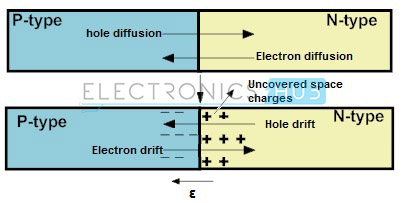
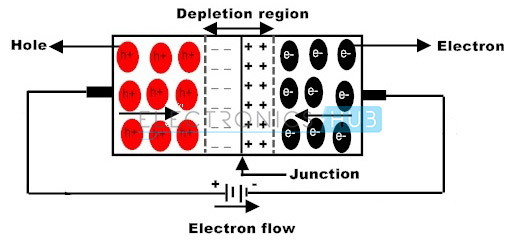


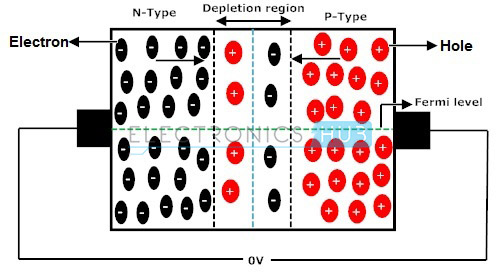
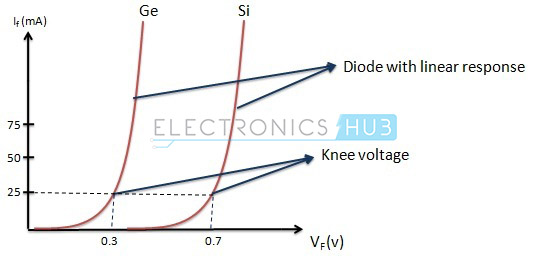
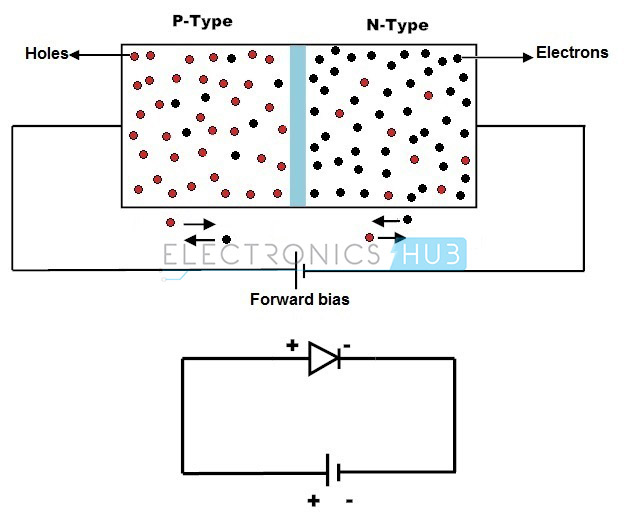
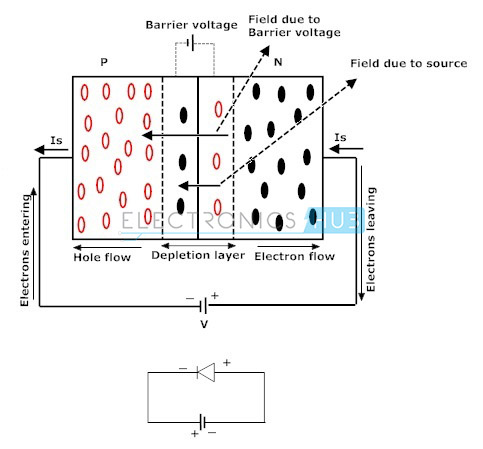


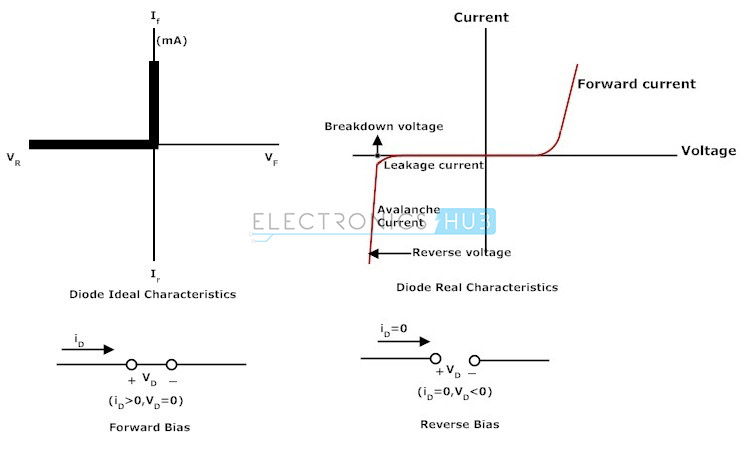


![]()